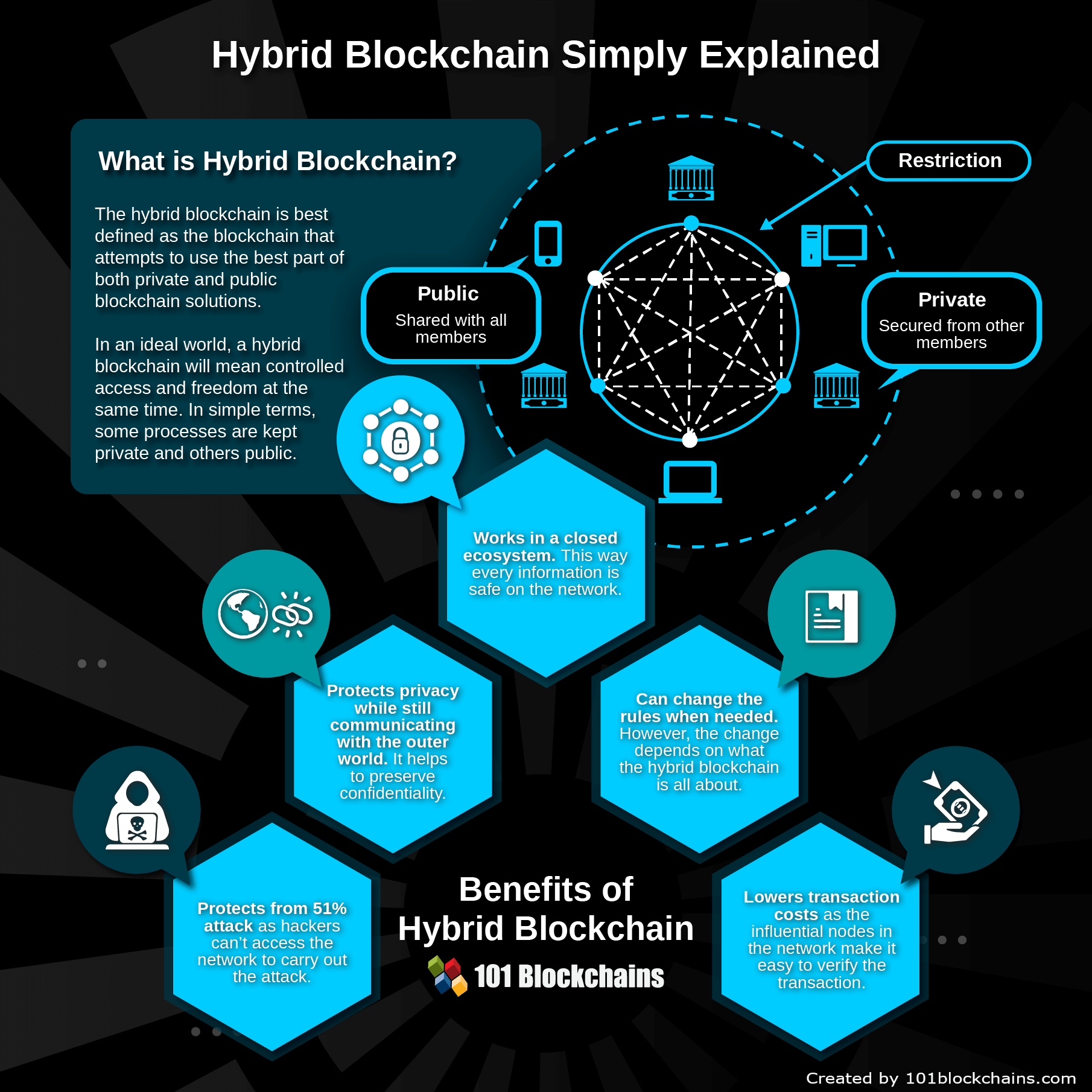Learn how blockchain truly works, master key definitions, and uncover what makes smart contracts so "smart." Dive into the fundamentals, gain valuable insights, and start your blockchain journey today!

- Blockchain
Diego Geroni
- on January 28, 2021
Hybrid Blockchain: The Best of Both Worlds
Hybrid blockchain is a revolutionary type of blockchain technology. In this guide, we will dive into the core elements of a hybrid blockchain and learn how it works.
The blockchain is uniquely transforming the world. It enables enterprises, governments, and other organizations to better handle their workflow and improve their systems with better solutions. Now, it’s changing how we store data, access it, and use it to improve the never-ending cycle of technological-growth. It also impacts other aspects of our technology, including how we instill trust in a network.
Blockchain can be used in three different ways: private, public, consortium, and hybrid. If you have read about blockchain in the past, you might have an idea of how private and public blockchain works. For those who don’t know, we will discuss them in detail below.
However, the third way, i.e., a hybrid, might impact the different industries. The hybrid blockchain is the mix of both the worlds, both private and public blockchain. This gives organizations better control over what they want to achieve rather than change their plans on the limitation of the technology.
The use of blockchain technology can be done in both financial and non-financial manner. With blockchain, it becomes impossible to tamper with data or hack into the system. The openness of the public blockchain brings people all around the world together, whereas the private blockchain ensures that a closed ecosystem can also thrive with blockchain capabilities.
In this article, we will go through hybrid blockchain and what it has to offer. We will also discuss the hybrid blockchain definition and understand it from the inside out. But first, let’s check out both private and public blockchain.
Build your identity as a certified blockchain expert with 101 Blockchains’ Blockchain Certifications designed to provide enhanced career prospects.
What is Public Blockchain?
As the name suggests, public blockchain is public in nature. When Bitcoin white paper came, it also mentioned blockchain in its public form. It also means that the public blockchain is open to all, and anyone can participate in it.
However, the question is why anyone would join a public blockchain? Here comes the incentive that a public blockchain has to offer. This, in return, improves the number of users, improving blockchain health and growth. Bitcoin does it exceptionally well.
For example, miners can participate and provide computational power to solve complex algorithms. By doing so, a transaction or block is mined. On the other hand, the miners are incentivized as they received bitcoin for the work they did. There will always be users and workers in a public blockchain environment to make it run smoothly. Fluidity is important, and that’s why incentivizing keeps it going.
Another example of public blockchain includes NEO, Ethereum, and so on.
Anyone with no limitation whatsoever can also create a public blockchain.
Start learning Blockchain with World’s first Blockchain Skill Paths with quality resources tailored by industry experts Now!
What is Private Blockchain?
Now that we have got a clear picture of what public blockchain has to offer. Let’s move on to the private blockchain. As you might have guessed it from the name, private blockchain are private.
In a private blockchain, the parties limit the access of the blockchain to its users. Users need to get access to the network before they can use it. Also, the access can only be taken from the authority who is managing the private blockchain.
As it is a private blockchain, things can change as they like. For example, the administrator can limit transactions based on their nature, speed, or intent. The control here gives private blockchain a great use-case for companies or organizations that want to benefit the blockchain but in a closed environment.
One more thing that you need to notice here is that private blockchain is not entirely closed off from public access. They can be accessed according to what the administrator has set things for.
For example, Quorum is a private blockchain-powered using the Ethereum network. It uses a new consensus mechanism and also has strict transaction/contract privacy. J.P.Morgan is the creator of Quorum. Other examples worth mentioning include Hyperledger and Corda.
Interested in learning more difference between private and public blockchain? Here is a guide to the public vs. private blockchain that you can check out.
Hybrid Blockchain Definition
The hybrid blockchain is best defined as the blockchain that attempts to use the best part of both private and public blockchain solutions. In an ideal world, a hybrid blockchain will mean controlled access and freedom at the same time.
The hybrid blockchain architecture is distinguishable from the fact that they are not open to everyone but still offers blockchain features such as integrity, transparency, and security.
As usual, Hybrid blockchain architecture is entirely customizable. The hybrid blockchain members can decide who can participate in the blockchain or which transactions are made public. This brings the best of both worlds and ensures that a company can work with its stakeholders in the best possible way.
We hope that you got a clear view of the hybrid blockchain definition. To get a much better picture, we recommend you check out some hybrid blockchain projects. XDC is one of those projects that take advantage of both public and private blockchain. It is created and managed by XinFin, a Singaporean company.
Please include attribution to 101blockchains.com with this graphic. <a href='https://101blockchains.com/blockchain-infographics/'> <img src='https://101blockchains.com/wp-content/uploads/2018/10/Hybrid_Blockchain.png' alt='Hybrid Blockchain='0' /> </a>
Verifiable Transactions
Even though transactions are not made public, but they are still verifiable when needed. Every transaction that takes place in the hybrid blockchain platform can be kept private and always open for verifiability when required. As blockchain is used, its most crucial aspect works here. Immutability. It ensures that each transaction is written once and cannot be changed in due time.
So, will it be secure as compared to public or private blockchain? The answer is yes. Even though a set of individuals controls it, they cannot change the transactions’ immutability and security. They can only control which transactions are made public and which are not.
How Do the Users Function in The Hybrid Blockchain?
Once a user gets the grant to access the hybrid blockchain platform, he can fully participate in the blockchain’s activities. He shares equal rights to do transactions, view them or even append or modify transactions. However, one thing that is kept a secret is the identity of the users from other participants. This is done to protect the user’s privacy.
When a user transacts with the other user, then only his identity is revealed by the party he is dealing with. To ensure that the above identification process is done correctly, companies and organizations carry out KYC (Know Your Customer) to make it work. Financial institutes especially need to handle it correctly as they cannot allow the transaction to be carried out by a user that is not entirely known to the blockchain.
The Anonymity of Public State
Even when the hybrid blockchain has limited anonymity for the users who take part in the network, public anonymity is still maintained. This way, no one outside the network can know about the users. This leads us to an exciting intersection of both the public and private systems.
The hybrid network offers all the critical features of a public blockchain, such as secure, transparent, immutable, and decentralized, but it also restricts the ability to access transactions, view, or change transactions in any way. Also, not everyone can use the network, which makes sure that confidential information doesn’t go out of the network. Thus, hybrid blockchain promotes more security as it utilizes both of the features.
Let’s check out the benefits of the hybrid blockchain.
Not sure how to build your career in enterprise blockchains? Enroll Now in How to Build Your Career in Enterprise Blockchains Course
Benefits of Hybrid Blockchain
We now know what is hybrid blockchain. We also have a clear understanding of other types of blockchain: i.e., private and public. Now, it is time to list the benefits of hybrid blockchain and what it has to offer.
- Works in A Closed Ecosystem: The number one advantage of hybrid blockchain is its ability to work in a closed ecosystem. That’s means that companies or organizations don’t have to worry about getting their information leaked when taking advantage of blockchain technology.
- Changes the Rules When Needed: Companies thrive on change. The good news about hybrid blockchain as they need to change rules. However, the nature of the change depends on what the hybrid blockchain is trying to do. However, don’t expect to change data or modify transactions in a hybrid system that handles band registry or user identity for verification purposes.
- Protecting From 51% Attack: Hybrid blockchain is immune to a 51% attack as hackers cannot have access to the network to carry out the attack.
- Protecting Privacy While Still Communicating with The Outer World: Even though private blockchain is best for privacy-related issues. However, they are limited when it comes to communicating with the outer world. Many companies may want to keep the privacy but also need to configure their blockchain so that they can communicate with all their shareholders, including the public.
- Low Transaction Cost: Another added benefit of using hybrid blockchain is to have a low transaction cost. Transactions are bound to be cheap as it requires few nodes to verify them. The most powerful nodes in the network make it easy to verify the transaction, which may take thousands of nodes in the public blockchain. The transaction fees can reduce to even 0.01$ per transaction.
Hybrid Blockchain Use Cases
Let’s now go through some of the use-cases for hybrid blockchain to get a better understanding.
Hybrid IoT
The first use-case that we want to discuss is the Hybrid IoT. The internet of things can be a tricky thing to manage with a complete public blockchain solution as it will give hackers free data to map nodes or even hack into them. With hybrid blockchain, the devices can be placed in a private network with access to the ones that only need them. Some aspects of the network can be made public depending on which data to share. A hybrid approach can solve many security issues.
Global Finance and Trade
Even finance can take advantage of the hybrid blockchain. XinFin uses a hybrid blockchain using Ethereum for the public component, whereas Quorum is for the private component of their solution. Their aim is to provide a global finance and trade platform using hybrid technology. They use DPOS (delegated Proof-of-Stake).
Curious about the Ethereum Technology ? Enroll now: The Complete Ethereum Technology Course
Banking
A hybrid blockchain can be an ideal solution to banking. As banks need to solve problems internally and also secure user information, they can use this approach. Even Ripple, a more focused centralized cryptocurrency, can move to a hybrid blockchain network if there is a change needed.
Supply Chain
Supply chains can also benefit hugely from the hybrid blockchain. As the supply chain is huge, it is essential for them to go hybrid. There cannot go either private or public blockchain. Many supply chain logistics companies have already started implementing it.
One big example that uses hybrid blockchain in the supply chain is the IBM food trust. They aim to improve efficiency throughout and the whole food supply chain. It is a network where everyone, including farmers, wholesalers, distributors, and others, take part. Walmart is also an active player in this project.
Governments
Blockchain can change how governments work. Even governments know that and have started the process of using blockchain in their governance. For example, the government can use blockchain to do the voting, create public identification database, record complex data, automate acquisitions, provide social/humanitarian assistance, and so on.
To make all these possible, hybrid blockchains must be used. It provides the government with the control they need and enables the public to access it. Totally private or public blockchain will not work as they either hinder user’s access or reveal too much data. The blockchain’s right control can ensure that the government stays in control while taking advantage of the blockchain.
Enterprise Services
Last but not least, we will also see a great change in enterprise services thanks to the hybrid blockchain. It can not only be used to build open-source technology but enterprise-grade solutions. For example, enterprises can use hybrid blockchain to automate their service and improve their reliability, trust, and transparency for both employees and the end-users—industries such as Aviation, Supply-Chain, and so on.
Start your blockchain journey Now with the Enterprise Blockchains Fundamentals
Private vs. Public vs. Hybrid
Let’s check out how the different types of blockchain perform when we compare them with one another.
| Public | Private | Hybrid | |
|---|---|---|---|
| Definition | The public blockchain is open to everyone where anyone can participate. | Private blockchain is controlled by owners and access is limited to certain users. | The hybrid blockchain is a combination of the public and private blockchain. This means that some process is kept private and others public. |
| Transparency | The public blockchain is completely transparent. | he private blockchain is only transparent to the users who are granted access. | Hybrid blockchain transparency depends on how the owners set the rules. |
| Incentive | Public blockchain incentivizes participants for growing the network. | The private blockchain is limited and hence have no similar incentive as that of a public blockchain. | Hybrid blockchain can opt to incentivize users if they want to. |
| Use-case | Can be used in almost every industry. Good for public projects. It is also good for creating cryptocurrency for commercial use. | Private blockchain is great for organization blockchain implementation as they require complete control over their workflow. | Hybrid is best suited for projects that can neither go private or public and have a lack of trust. The supply chain is a great example. It is also effective in banking, finance, IoT, and others. |
| KYC needed | No | Yes | Yes |
| Transactional Cost | Costly | Not so costly | Not so costly |
| Carries basic property of blockchain | Yes | Yes | Yes |
Is Hybrid and Federated (Consortium) Different?
On the surface, they might sound identical, but that’s not the reality. Both federated and hybrid uses a different approach and has their unique characteristic. By knowing these characteristics, you will be able to equip yourself with the knowledge on which one to choose for your business or organization. Let’s see how hybrid blockchain vs consortium blockchain pans out.
Consortium Blockchain
A group manages consortium blockchain. The group decides on how the blockchain will function. Also, there is limited access, and the group decides who gets the access in the first place. The benefits of having strict access are obvious. For example, limited access means faster transactions, high scalability, and better transaction privacy.
Hybrid Blockchain
The hybrid blockchain is a combination of public and private entities. The best way to describe it is using a public blockchain where a private network is hosted. This means that there is restricted participation that is controlled through the private blockchain itself.
Technically, it works by generating the hashed data blocks using the private network and then storing that data into public without compromising data privacy.
Unlike federated blockchain, hybrid blockchain provides flexible control over the blockchain. This means that the control over data shared is not ideal and is not better than that of a federated one. The best use case of hybrid blockchain is scalability and decentralization.
Check out the table below to learn more about hybrid blockchain vs consortium blockchain.
| Hybrid Blockchain | Consortium Blockchain | |
|---|---|---|
| Access | Some instances are public, and some are restricted | Only selected participants get full access |
| Transaction Speed | Fast | Fast |
| Authority | Partially decentralized | Decentralized |
| Privacy | Partial | Partial |
Start learning Blockchain with World’s first Blockchain Career Paths with quality resources tailored by industry experts Now!
Concluding Thoughts: Is Hybrid Blockchain The Future?
A public or private blockchain cannot solve every problem out there. For organizations and companies that want to take advantage of the blockchain technology but don’t want to expose their critical business data and process to the whole world!
We went through private, public, and eventually hybrid blockchain to understand it. If you are still confused with these different variants of blockchain and want to learn more about them, then check out our blockchain courses.
*Disclaimer: The article should not be taken as, and is not intended to provide any investment advice. Claims made in this article do not constitute investment advice and should not be taken as such. 101 Blockchains shall not be responsible for any loss sustained by any person who relies on this article. Do your own research!








1 Comment
Very informative read on the why and what of hybrid blockchain…